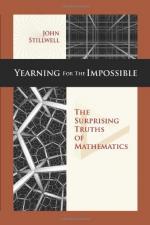|
This section contains 1,717 words (approx. 6 pages at 300 words per page) |

|
Geometric objects that cannot be constructed in three-dimensional space are considered "impossible." What makes them intriguing is that despite this difficulty, some representation of them is possible. Even though they can never be built or held, it is possible to imagine what they would look like and to learn about how these impossible objects behave.
Local Versus Global
In the study of mathematics, distinctions are routinely made between the local properties of an object—what small pieces of the object look like—and the properties of the object as a whole. Impossible objects are all "wellbehaved" locally; it is only when we consider them globally that contradictions arise.
Consider two lithographs by Dutch artist M. C. Escher. (Although not shown in this entry, these artworks are easily viewed on various Internet web sites and on books of Escher's art.) The first is "Belvedere," created in 1958. At...
|
This section contains 1,717 words (approx. 6 pages at 300 words per page) |

|


